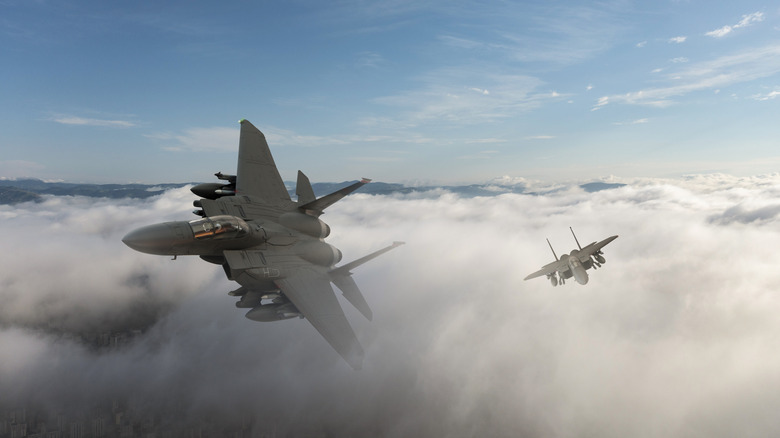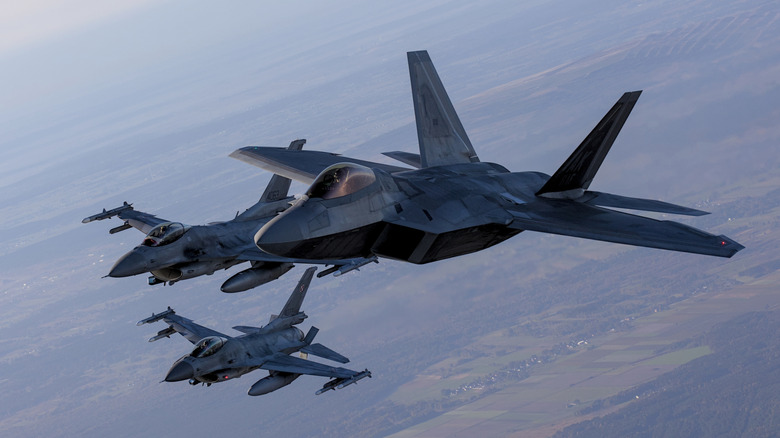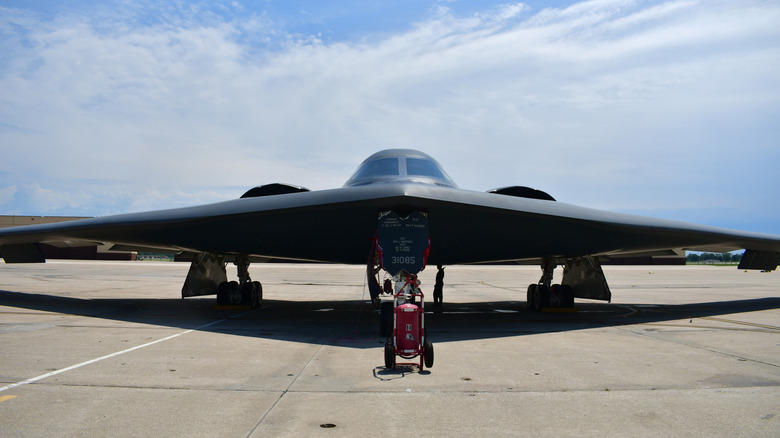What Do Those Letters And Numbers On Military Aircraft Mean?
Boeing 747, Airbus A330, Bombardier CRJ100, Embraer ERJ 610, Lockheed Martin F-22 Raptor, Lockheed Martin F-15 Eagle, F-16 Fighting Falcon, and of course, "T2: Judgement Day." What in the heck are all those letters about? And did you know that there's also a Boeing 707, 717, 727, 737, 757, 777, and 787? It's almost like there's a pattern to plane designations that isn't totally random — and this includes both commercial and military jets. All those funny letters and numbers date to the U.S. Tri-Service Aircraft-Designation System, a naming convention meant to describe the specifics of each aircraft.
Created by the Department of Defense (DoD) back in 1962, the Tri-Service system borrows from the aircraft designation system that the Air Force used from 1948 to 1962. When this system was created, it sought to unify disparate systems used by different branches of the U.S. military, including the Army and Navy. The DoD's naming system has been updated regularly over the years, with the latest version dating to the DoD's 2020 Air Force Policy Directive (AFPD) 16-4, which replaced an earlier 2014 version.
This excessively dry and tedious document outlines in exhaustive detail all the ins and outs of the DoD's current Mission Design Series (MDS), as the alphanumeric naming system is now dubbed. There's a painstaking, standardized approval process for monikers that includes standard designators like design number and series, non-standard designators like vehicle type, designations for declassified vs. classified aircraft, each craft's "popular names" (like Raptor for the super advanced F-22), and more.
The Department of Defense's painstaking MDS naming system
We'll be honest with you: You'd probably perish of boredom if we went into details about the Department of Defense's (DoD) Mission Design Series (MDS), the system they use to give aircraft designations like F-15, F-16, F-35a, etc. So, we'll stick to the broad strokes.
First off, even though jets might be the first thing that come to mind regarding MDS, the system covers aircraft of all types. This includes helicopters like the HH-60G Pave Hawk, bombers like the BB-52H Stratofortress, support craft like the A-10C Thunderbolt II, tankers like the KC-46A Pegasus, recon craft like U-2S/TU-2S Dragon Lady, as well as experimental craft, drones, training craft, weather recon craft, transport craft, AWACS (command craft), and more. In other words, we're talking about an extensive, sprawling, all-encompassing naming system that is vastly more detailed than you might realize. Even missiles, probes, and satellites get their own designations, like AGM-84N (an anti-ship missile). Also: "Stratofortress" wins the prize for best (and most ridiculous) popular name, although "Dragon Lady" is up there.
Looking at alphanumeric naming, we've got four basic aircraft designation letters: status prefix, modified mission, basic mission, and vehicle type. In order, examples include X (experimental), L (cold weather), E (special electronic installation), and D (UAV control segment, where UAV means unmanned aerial vehicle, aka, drone). F, for example, is a modified and basic mission designation meaning "fighter" (like the F-15) which makes sense. Rules for numbers are more opaque and not fully listed, but relate to the aircraft's manufacturing line and design.
Choosing an alphanumerical and popular aircraft name
Now that we know that alphanumeric naming consists of numbers related to the function of a craft and letters related to the craft's design, we can go a little deeper to crack aircraft name meanings. There are design numbers and series letters, for instance, to denote a certain craft's model numbers or the craft in a series, like MH-139A or F-16N. The former craft differs from the MH-139 and the "N" in the latter means Navy. There are a bajillion other factors involved in the naming process, but manufacturer code letters stand out. LO means Lockheed Martin, BN means the Boeing company in Renton, Washington as opposed to BO in Seattle, GO means Goodyear, etc.
Finally, we can look at the Air Force Policy Directive (AFPD) 16-4 (they really love letters and numbers) to see how a craft is finally granted its Mission Design Series (MDS). There's even a form letter on page 36 of the document to outline how to submit an MDS proposal. Using the AC-130J as an example, it says that its manufacturer is Lockheed Martin, the popular name is Spectre II, its using service (military branch) is the USAF, USSOCOM, its engine/motor type is a Rolls-Royce AE2100D3, it has four engines total, and there's a paragraph describing features like "electro-optical/infrared sensors" and "small precision guided munitions."
Regarding the thing that we all think is coolest of all — the popular name — there are separate requests in a separate form letter. Referring to the AC-130J, it lists three possible options: Ghostrider, Waverider, and Ghost Rain. Ghostrider, as it turns out, is its actual popular name.


